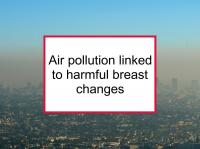Long-term exposure to air pollution has been linked to increased breast cancer risk and reduced survival, although not all studies are in agreement. High levels of nitrogen dioxide (NO2, a marker of traffic-related pollution), polycyclic aromatic hydrocarbons (PAHs), and ambient particulate matter each have been linked to breast cancer.
Now a new study has reported that exposure to fine particulate matter is linked to changes in normal breast tissue associated with increased breast cancer risk.
Airborne particulates may reduce breast cancer survival
Ambient particulate matter consists of all the solid and liquid particles suspended in air at a given location. It includes soot, smoke and other components of exhaust, as well as dust, pollen, and liquid droplets. Characteristics of particulates that are known to influence health include the size of the particles, as well as the presence of metals, PAHs, other organic components, and toxins. California regulates two size classes of particle, measured in microns ( μm, one-millionth of a meter) — particles up to 2.5 μm and particles up to 10 μm in size (which encompasses the smaller class). One 2013 California study reported that breast cancer patients living in areas with high levels of either < 2.5 μm or < 10 μm had shorter survival than those living in areas with relatively low exposures. The greater the exposure, the higher the risk of early death.
Air pollution and breast cancer
The mechanism of action by which exposure to air pollution increases breast cancer risk remains unclear. It has been proposed that components of air pollution act as xenoestrogens, man-made compounds that bind to and activate estrogen receptors. Occupational studies have reported associations between breast cancer and exposure to certain chemicals that are also found in urban air. Breast density (an important breast cancer risk factor) has been reported to be higher among women with relatively high exposure to < 2.5 μm ambient air particulate matter and ozone. Air pollution also appears to increase systemic inflammation, another breast cancer risk factor.
Latest research finds fine particulate matter alters breast tissue
The study referenced above was designed to investigate the effects of outdoor air pollution on involution of terminal duct lobular units (TDLUs, also known as lobules). Most breast cancers arise in TDLUs, which are structures that produce breast milk during lactation. Reduced TDLU involution (the atrophy of milk-producing structures in the breast) has been shown to be a marker of increased breast cancer risk.
The study included breast tissue specimens from 1,904 women aged 18 to 75 with no history of cancer who donated to the Susan G. Komen Tissue Bank between 2009 and 2012. Annual fine particulate matter (< 2.5 μm in diameter or PM2.5 total mass (μg/m3)) data as of 2009 at each participant's home address was estimated from Environmental Protection Agency (EPA) data plus air quality monitoring data. TDLU involution was measured by TDLU counts. PM2.5 total mass was found to be associated with higher TDLU counts (lower involution) among all participants, both premenopausal and postmenopausal.
The authors identified three geographic groups with varying levels of PM2.5 exposure relative to average population levels: high, medium, and low. Women with either medium or high levels of exposure had significantly higher TDLU counts than those with low levels. The size of the associations was stronger among postmenopausal women, although this result did not rise to statistical significance. The authors conclude that higher PM2.5 levels were associated with reduced TDLU involution, suggesting that exposure to air pollution might influence normal tissue In a manner that could affect breast cancer risk.
Please see our air pollution tag for more information.
